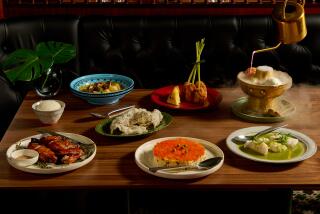RESTAURANTS / MAX JACOBSON : Pritikin Chinese? A Little ‘Diet’ Oil Goes a Long Way
- Share via
Mandarin Pritikin. I had to blink when I saw the sign.
It’s not that the combination is necessarily implausible. The idea just takes a little getting used to, because anyone familiar with the Pritikin program for weight reduction and cardiovascular maintenance knows about its low-fat, low-salt and (let’s be honest) low-sensory-threshold approach to eating. Chinese restaurant food, though, tends to be oily, salty and wonderfully tasty.
These twain meet at a place called the Cathay Newport. It really would be nothing more than just another chic, modern Chinese restaurant were it not for the eccentric inclusion of several dishes steamed without oil, starch, sugar or salt. (I have to congratulate the owners on this brilliant marketing stroke--who can afford oil these days?)
Still, it is a tastefully designed place, a cavernous room with a swank bar nestled into one corner and comfy booths to sink into. There are three huge Chinese paintings dominating their respective walls, and the pastel green and beige color scheme relaxes you from the moment you enter.
Then there’s that section of the menu: “Pritikin menu for the health conscious.” Each of the dishes’ names there begins with the word dieter’s and ends with the word delight (except for one called “Cathay special”). Unfortunately, dieter’s delight sounds like a self-contradictory phrase and, also unfortunately, that impression is not dispelled here.
It’s not that any of these dishes is bad. Quite the contrary. Most of these meats and vegetables have a fresh, clean taste and are in fact preferable to a lot of the Americanized fare the restaurant insists on serving non-Pritikin diners.
But this is only the case after they have been doused in a good-tasting garlic sauce that the management craftily brings on the side. Small detail. Of course, this is tantamount to ordering a low-fat yogurt brownie sundae, you know, the one with the hot fudge cascading down the sides.
Anyway, after sampling a couple of Pritikin dishes, I wanted to sample the rest of the menu and made the mistake of asking our waitress to do most of the ordering. I told her we wanted some real Chinese dishes--”none of that Westernized stuff”--but what we got was the po po platter: limp, tepid, meatless egg rolls; batter-fried shrimp I could have sworn were Mrs. Paul’s, and three retro-style barbecued spareribs roughly the color of Madonna’s lipstick.
Hold it right there, we said. We’ll order for ourselves now, if it isn’t too late. Things improved dramatically. First we had a plateful of steamed won ton, 10 to an order, in hot pepper sauce. The won ton were cooked al dente and tasted like an exotic version of Italian pasta in its fiery sauce.
Then came the first of the main courses, filet of fish in a light wine sauce, which turned out to be the best dish of the evening. The fish (rock cod that day) had been lightly battered and drizzled with rice wine and minced garlic. Brought out on a sizzling platter, it was flaky and sweet, with just the slightest hint of pungency.
After that, we sort of let ourselves get carried away. The maitre d’ suggested an off-menu special, an absolutely marvelous combination of scallops and fresh asparagus. It came in an egg white-based sauce that is called “velvet” on a great many Chinese menus, but not this one.
He also insisted we try the lobster in black bean sauce, a Cantonese-type dish consisting of a mountain of shelled lobster meat peering out from under its onetime shell. The salty, fermented soy bean is a natural complement to the silky sweetness of lobster, and this is one of the most satisfying dishes in the Chinese repertoire.
Inspired by now, we decided to make it a full-fledged banquet. So we finished up with crisp duckling, Peking style, and a sumptuous noodle dish with chicken.
Perhaps because we’d ordered so many dishes, the maitre d’ was nice enough to wrap slices of deep-fried duckling and scallion in a rice flour crepe, then smear the whole mixture with plum sauce. But good intentions do not a delicacy make. The duck was sodden with grease. It actually soaked right through the crepe.
The point to all of this, I suppose, is that Cathay Newport can be a pretty good restaurant, provided you know what to order. It’s best to avoid the deep-fried dishes, anything fried with batter and any Westernized combinations (that is, dishes that mingle meats with seafoods or list more than three main ingredients).
The vegetable, noodle and rice dishes are generally sound. Both spicy bean curd and hot spiced eggplant are delightful, and the noodle and rice dishes are fresh and made with a minimum of oil.
Which is not the same as no oil at all. I’d be the first to admit the health benefits of Pritikin cuisine, and I applaud this restaurant’s efforts in making it available. Just make sure I get a little oil, salt and sugar to go along with my food here. Then I’ll be happy to eat as much of it as my doctor advises.
Cathay Newport is moderately priced. Hot appetizers are $3.50 to $12.75. Soups are $4.75 and $4.95. Noodle and rice dishes are $5.75 to $9.50. Cathay specialties are $9.95 to $29.50. Pritikin dishes are $10.25 to $16.50. The lunch menu, served until 3 p.m., is considerably lower in price.
CATHAY NEWPORT
1220 Bison Ave., A-7, Newport Beach.
(714) 759-3388.
Open for lunch and dinner from 11 a.m. through 10:30 p.m. daily.
American Express, MasterCard and Visa accepted.
More to Read
Eat your way across L.A.
Get our weekly Tasting Notes newsletter for reviews, news and more.
You may occasionally receive promotional content from the Los Angeles Times.










